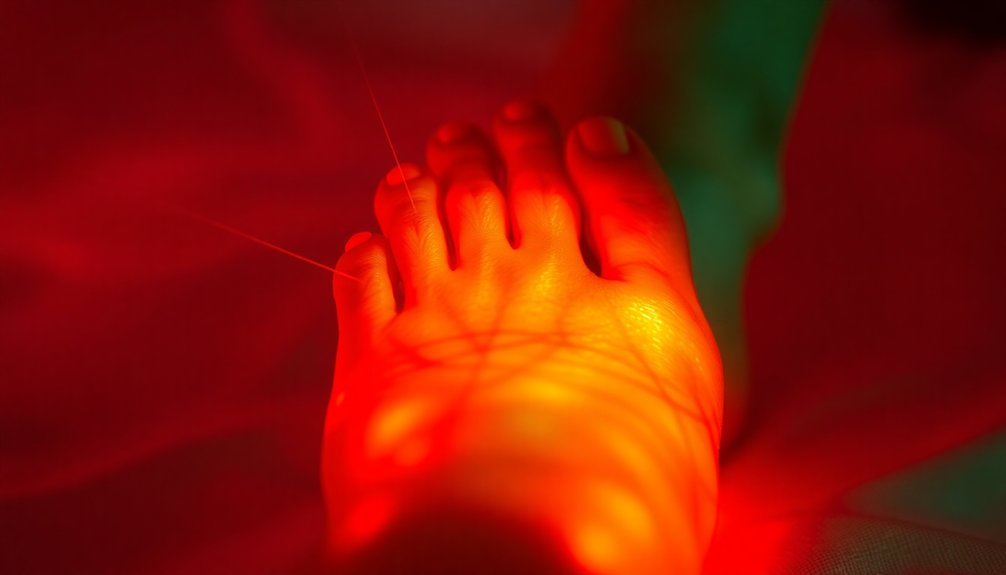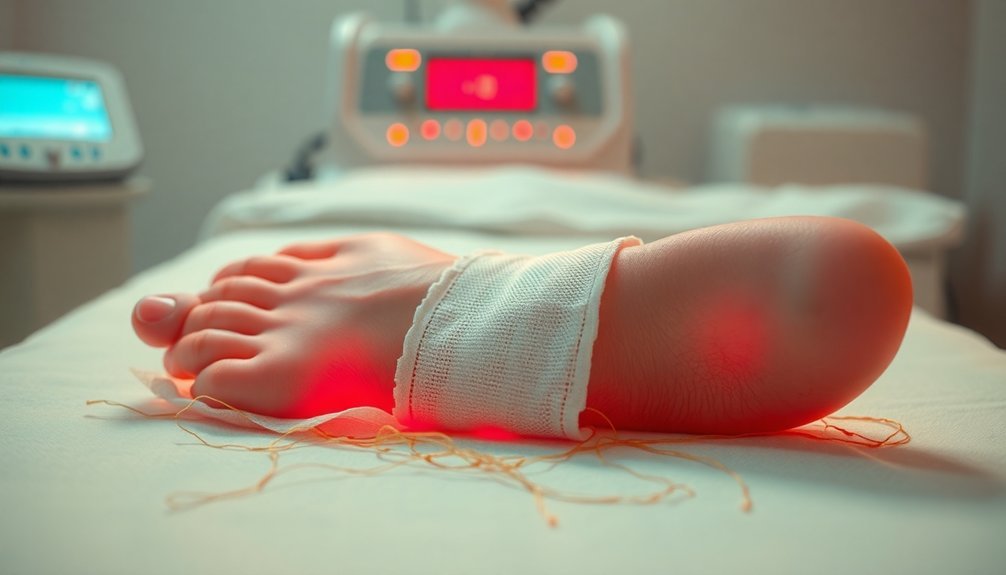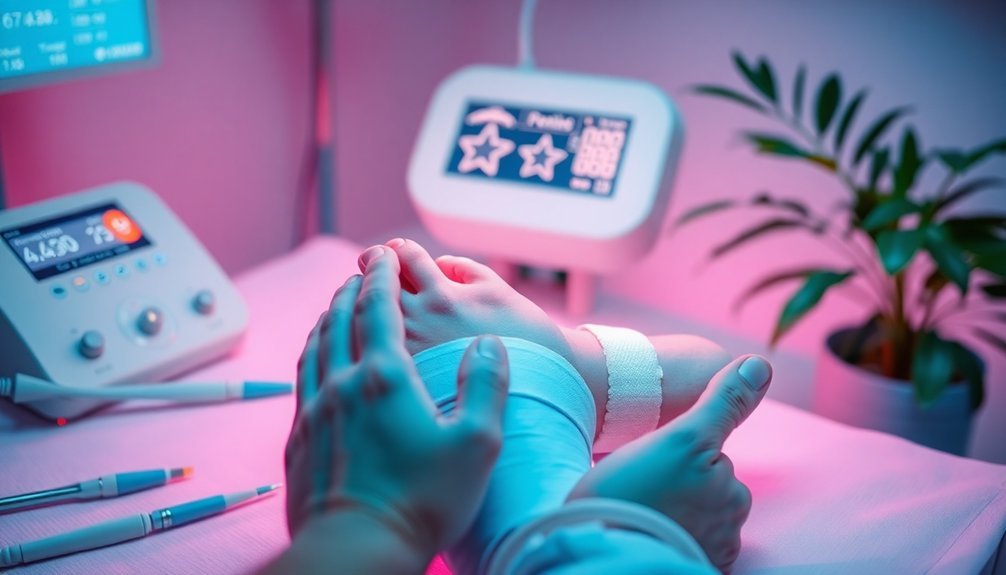If you're looking for effective infrared protocols for diabetic wound recovery, consider these three options. First, Monochromatic Infrared Energy (MIRE) uses pulsed light to stimulate healing and improve sensation in patients. Next, Low-Level Infrared Light Therapy (LLLT) can greatly reduce ulcer size and boost healing chances. Finally, combining infrared therapy with conventional methods enhances blood circulation and speeds up recovery. Each protocol offers unique benefits that cater to different needs. If you're curious about how these therapies can specifically aid recovery, there's more to discover that can help you navigate your options.
Monochromatic Infrared Energy (MIRE)

Monochromatic Infrared Energy (MIRE) harnesses the power of pulsed infrared light to promote healing in diabetic wounds and other conditions. It operates at a wavelength of 880 nm through pads that contain 60 superluminous infrared diodes. Each treatment session lasts between 30 and 45 minutes, during which the infrared energy is delivered uniformly to the skin.
MIRE works primarily through photobiostimulation, improving circulation by increasing the plasma levels of nitric oxide, a potent vasodilator. You can administer MIRE devices in clinical settings or even at home.
This therapy shows promise for treating various conditions, including cutaneous ulcers, diabetic neuropathy, and musculoskeletal injuries. Studies suggest significant improvements in sensation among patients with diabetic peripheral neuropathy, with around 98% reporting improved sensation after six treatments. Additionally, patients noted reductions in pain and enhanced balance. Furthermore, as DPN prevalence increases with the duration of diabetes, the urgency for effective treatments like MIRE becomes even more critical in managing wound healing.
Although MIRE is still considered investigational for certain applications, it's receiving attention for its efficacy. With supportive recommendations from the Association for the Advancement of Wound Care, you're encouraged to explore this innovative therapy for promoting wound healing and improving quality of life.
Low-Level Infrared Light Therapy
Low-Level Infrared Light Therapy (LLLT) stands out as an effective treatment option for promoting wound healing in diabetic patients. Research shows that LLLT can lead to a significant reduction in ulcer size, with an average decrease of 4.2 cm² in the therapy group. Patients receiving LLLT were 4.65 times more likely to experience complete healing compared to those who did not.
The therapy works through photobiomodulation, influencing various cellular processes. It stimulates nitric oxide production, enhancing foot perfusion and encouraging cellular migration and proliferation. These mechanisms also promote ATP production, further aiding in tissue repair. This is crucial, as impaired wound healing often results from factors such as neuropathy and inadequate angiogenesis in diabetic patients.
For ideal results, you can utilize specific wavelengths, such as 633 nm, 810 nm, or 980 nm, and apply the therapy three times a week. The recommended fluence is 2.35 J/cm² for diabetic wounds.
Patients typically report a significant decrease in pain and improved blood flow, contributing to enhanced quality of life.
Low-Level Infrared Light Therapy offers a cost-effective, painless solution that not only accelerates healing but also helps prevent complications like amputations.
Combined Infrared and Conventional Therapy

Combining infrared radiation with conventional therapy offers a powerful approach for diabetic wound recovery. Studies reveal that this combination markedly improves healing outcomes compared to conventional dressing alone. You'll notice a faster reduction in ulcer size, enhanced granulation tissue formation, and decreased inflammation and wound exudation. This method is more effective than routine dressing techniques.
The mechanisms behind this effectiveness include increased blood circulation and new capillary formation, which boost oxygen and nutrient delivery to the wound. Additionally, infrared radiation stimulates nitric oxide production, benefiting those with diabetic and venous ulcers. Recent research from a Colorado study(Colorado Study Overview) indicates that patients experienced significant improvement using infrared devices as an adjunct treatment.
You'll also benefit from enhanced lymphatic activity that aids in clearing away debris and toxins from the area, while the stimulation of fibroblast production helps create vital wound-healing components like collagen.
For best results, the recommended protocol involves utilizing infrared therapy three times a week for five weeks. Sessions last about 20 minutes, with the infrared source kept at a safe distance.
This combination therapy not only reduces pain but also minimizes severe complications related to untreated foot ulcers. Engaging healthcare providers in understanding this treatment is essential for improving patient care.
Frequently Asked Questions
How Long Should Infrared Therapy Sessions Last for Optimal Results?
For ideal results, you should aim for therapy sessions lasting between 20 to 40 minutes. Regularity is key, so consider attending sessions three times a week for several weeks to enhance your healing process.
Are There Any Side Effects of Using Infrared Therapy?
Yes, using infrared therapy can lead to side effects like headaches, eye strain, skin irritation, and dehydration. Always consult a healthcare professional and follow safety protocols to minimize these risks and guarantee a safe experience.
Can Infrared Therapy Be Used With Other Treatments?
Yes, you can use infrared therapy alongside other treatments. Just remember to consult your healthcare provider to guarantee effective integration and avoid potential interference with existing therapies for ideal healing outcomes.
How Often Should Treatment Be Administered During Recovery?
You should administer treatments three to six times a week, depending on your specific condition. Consistent sessions help promote faster healing and improve wound recovery, so follow your healthcare provider's recommendations for ideal results.
Is Infrared Therapy Suitable for All Diabetic Patients?
Infrared therapy isn't suitable for all diabetic patients. You should consult with your healthcare provider to assess your specific condition, as individual factors like type of wound and overall health can affect treatment efficacy.
In Summary
Incorporating infrared protocols like Monochromatic Infrared Energy, Low-Level Infrared Light Therapy, and Combined Infrared and Conventional Therapy can greatly enhance diabetic wound recovery. By choosing the right approach for your specific needs, you can promote healing and improve overall outcomes. Remember, consulting with healthcare professionals is essential to guarantee you're making informed decisions about your treatment options. Embracing these advancements might just lead you to a quicker path to recovery and better health.





Leave a Reply